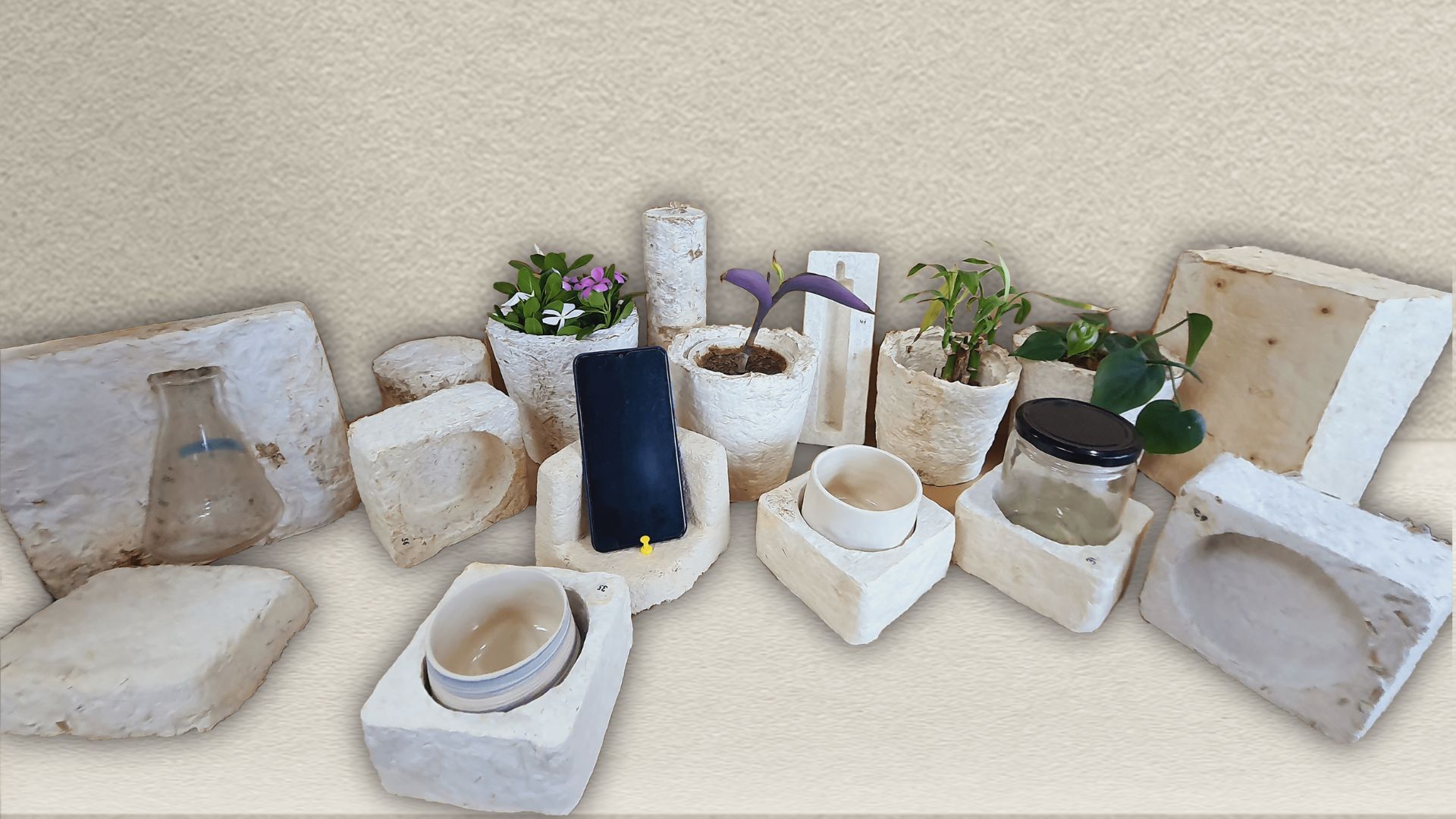Ecovia and Dharaksha Ecosolutions offer sustainable alternatives to plastic packaging for the e-commerce industry.
July 2022

Dharaksha Ecosolutions has created a sustainable packaging alternative from crop stubble waste. Courtesy Dharaksha Ecosolutions
Packaging is ubiquitous in our everyday lives and provides countless conveniences, including shipping of goods all over the world. However, the explosion of single-use plastic packaging to transport and deliver goods has placed a heavy burden on the environment. Many countries, including the United States and India, are now taking steps to introduce regulations that drive sustainability, and answer growing public concerns about harmful packaging waste. Innovators like Dharaksha Ecosolutions and Ecovia, both Nexus-trained start-ups, have stepped up to introduce solutions that make packaging products more sustainable.
Ecovia was created in 2021, during the Covid-19 pandemic lockdown, when millions of people were confined to their homes and depended on e-commerce deliveries for basic commodities. Dhwani Mehta, Pranjul Jain and Parikshit Joon created the start-up with the intent of reducing waste and promoting sustainability.
“The one thing that bothered us all was the packaging material and sheer waste that our purchases were accompanied by,” says Mehta. “What if this ridiculous amount of e-commerce packaging could be reused–reducing waste and making the house less cluttered?” They started a pilot project in Surat, which got an encouraging response, and Ecovia was born.
Dharaksha Ecosolutions co-founders Arpit Dhupar and Anand Bodh wanted to find solutions to curb stubble crop burning. Farmers in India burn an estimated 23 million tons of crop stubble every year as a way of quickly and cheaply clearing their fields between harvests. The emissions can result in severe health risks and aggravate conditions like asthma and chronic bronchitis.
Deeply concerned about the air pollution that would engulf north India from September to November every year, Dhupar and Bodh toured villages in Haryana and Punjab to understand why farmers burn stubble, even though their families are the first to be affected by the pollution. At the same time, the duo wanted to find a way to use the crop stubble so that farmers wouldn’t burn this agricultural waste.
Addressing everyday problems
Dhupar and Bodh explored the possibility of making different products from stubble waste, including vermicompost, biogas and paper pulp. They finally zeroed in on packaging material as it would help address two problems—air pollution and unsustainable plastic or petroleum-derived packaging. They started Dharaksha in 2020, which is based in New Delhi.
“It took us about two years to crack the research and development process and create a packaging material that can replace thermocol and plastic,” says Dhupar. Dharaksha’s packaging material is made entirely from crop stubble and is nearly identical in look and feel to thermocol, which is widely used as packaging material.
Dhupar says Dharaksha’s packaging has better cushioning capabilities, texture and surface finish than thermocol. It is also water-resistant, fire-retardant and customizable in shape. “Our packaging is completely biodegradable,” he says. “You can easily dump it as part of your kitchen waste and it will decompose in 60 days.”

Ecovia, on the other hand, approaches the problem from a different perspective. It focuses on direct-to-consumer brands, helping them switch to reusable packaging. “Imagine yourself seated in a bathtub. The water is overflowing. Would you start mopping the floor, or simply turn off the tap? We, at Ecovia, find more value in reusing rather than recycling,” says Mehta.
Many brands have taken measures like eliminating plastic from their supply chain. But Mehta feels this is not enough. “The closest to a perfect solution to the use of excess plastic packaging is reusing at commercial and scalable levels,” she says.
Ecovia’s packaging material is highly durable, and is designed to be reused almost 100 times. “The material is recycled polyester that is made of plastic bottles. It is essentially the same material that is used to make backpacks. It is water and tear-resistant,” says Mehta.
Reaching homes
Ecovia’s business model is unique as the consumer is rewarded for acting responsibly and returning the packaging for reuse. Once the delivery from a partner brand reaches the customer, they can simply scan the QR code printed on the packaging to schedule the Ecovia package return.
As soon as the return is picked up, customers receive a reward coupon as a “thank you” for their conscious step toward sustainability. “This reward is essentially tied to the same brand from which the purchase was made. So maybe a 10 percent or 25 percent off on your next purchase. We’ve reached close to 70 percent in the returns segment,” says Mehta. Ecovia has partnered with more than 50 brands including WOW Skin Science, Otipy, GO DESi and Suta.
Dharaksha too has successfully added many corporate clients, including Dabur and Barosi, for its biodegradable packaging material. The company is already looking to scale up in other product applications, says Dhupar. “In the future, we also want to get into building furniture by increasing the strength of the materials,” he adds. “This would also help in preventing deforestation as we would be able to replace wood with our material.”
Jason Chiang is a freelance writer based in Silver Lake, Los Angeles.
COMMENTS